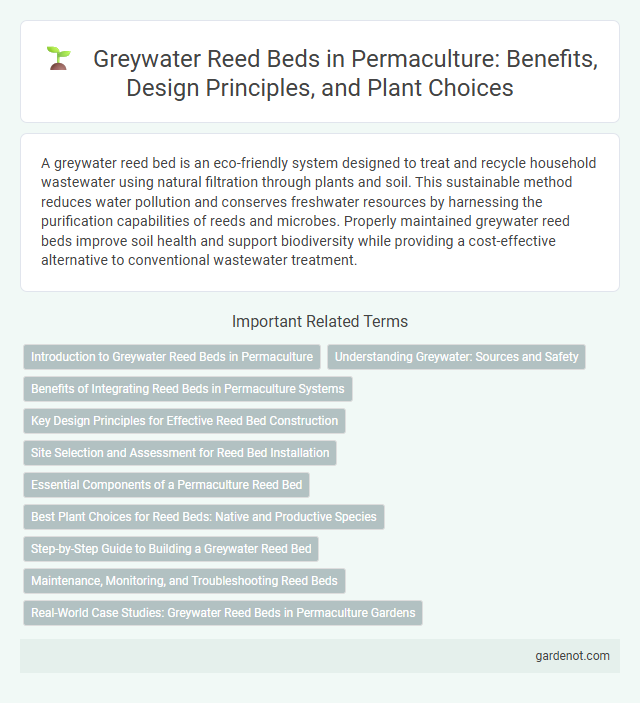A greywater reed bed is an eco-friendly system designed to treat and recycle household wastewater using natural filtration through plants and soil. This sustainable method reduces water pollution and conserves freshwater resources by harnessing the purification capabilities of reeds and microbes. Properly maintained greywater reed beds improve soil health and support biodiversity while providing a cost-effective alternative to conventional wastewater treatment.
Introduction to Greywater Reed Beds in Permaculture
Greywater reed beds are sustainable wastewater treatment systems that utilize natural processes involving reeds and microorganisms to purify household greywater. These systems enhance water conservation by filtering contaminants through sediment, roots, and microbial activity, making treated water suitable for irrigation in permaculture gardens. Integrating greywater reed beds promotes ecological balance, reduces water waste, and supports soil health in regenerative agricultural practices.
Understanding Greywater: Sources and Safety
Greywater originates from household activities such as bathing, washing dishes, and laundry, excluding toilet waste, making it less contaminated than blackwater. Proper treatment in a greywater reed bed relies on natural filtration through reeds and microorganisms that remove pathogens and organic matter, ensuring safe reuse for irrigation. Understanding greywater composition and safety protocols is essential to prevent health risks and maximize sustainable water recycling in permaculture systems.
Benefits of Integrating Reed Beds in Permaculture Systems
Integrating greywater reed beds in permaculture systems enhances water recycling by efficiently filtering and purifying household wastewater through natural biological processes, reducing reliance on freshwater resources. Reed beds promote biodiversity by creating microhabitats for beneficial microbes and aquatic plants that contribute to nutrient cycling and soil health. This sustainable water management technique also mitigates pollution risks, supports plant irrigation, and improves overall system resilience.
Key Design Principles for Effective Reed Bed Construction
Effective greywater reed bed construction relies on optimizing hydraulic retention time to ensure thorough filtration and nutrient absorption. Selecting appropriate reed species such as Phragmites australis enhances pollutant degradation through robust root systems and microbial activity. Incorporating layered substrates with gravel and sand facilitates efficient water percolation and supports aerobic conditions essential for waste treatment.
Site Selection and Assessment for Reed Bed Installation
Selecting an optimal site for a greywater reed bed requires analyzing soil permeability, sunlight exposure, and proximity to water sources to ensure efficient filtration and plant growth. Assessing the slope and existing vegetation helps prevent waterlogging and promotes natural nutrient cycling within the system. Proper evaluation of these factors maximizes the reed bed's capacity for sustainable greywater treatment and ecological balance in permaculture design.
Essential Components of a Permaculture Reed Bed
A permaculture greywater reed bed includes key components such as a settling tank to remove solids, a planted filtration bed with specific reed species like Phragmites australis, and a drainage system to ensure proper water flow and aeration. The reed bed relies on microbial activity in the root zone to break down contaminants, facilitating natural purification of household greywater. Proper sizing, substrate composition, and plant selection are essential to maximize the efficiency and longevity of the greywater treatment system.
Best Plant Choices for Reed Beds: Native and Productive Species
Choosing native reeds like Phragmites australis and Typha latifolia for greywater reed beds enhances filtration efficiency and ecosystem compatibility. These species thrive in wet conditions, promote nutrient uptake, and support microbial activity essential for water purification. Incorporating productive plants such as Carex and Schoenoplectus can improve biomass production while maintaining biodiversity and long-term system sustainability.
Step-by-Step Guide to Building a Greywater Reed Bed
Constructing a greywater reed bed begins with selecting an appropriate location that ensures proper drainage and avoids contamination of potable water sources. Excavating a basin, typically 0.5 to 1 meter deep, is followed by layering gravel and coarse sand to facilitate filtration and root anchoring of wetland plants like Phragmites australis (common reed). Installing a perforated pipe system distributes greywater evenly, with periodic maintenance to remove sludge and replace plant material essential for optimal nutrient removal and water purification.
Maintenance, Monitoring, and Troubleshooting Reed Beds
Regular maintenance of greywater reed beds involves inspecting plant health, removing accumulated debris, and ensuring proper water flow to prevent clogging. Monitoring water quality parameters such as pH, nutrient levels, and oxygen content helps detect early signs of system imbalance. Troubleshooting common issues includes addressing root overgrowth, sediment buildup, and uneven water distribution to maintain optimal filtration efficiency.
Real-World Case Studies: Greywater Reed Beds in Permaculture Gardens
Greywater reed beds in permaculture gardens demonstrate effective natural wastewater treatment by utilizing reeds such as Phragmites australis to filter and break down contaminants. Case studies from Australia and New Zealand highlight significant reductions in household greywater pollution levels, achieving over 80% nutrient removal and promoting groundwater recharge. These systems integrate seamlessly into garden ecosystems, enhancing soil fertility while supporting sustainable water management practices in permaculture designs.
Greywater reed bed Infographic

 gardenot.com
gardenot.com